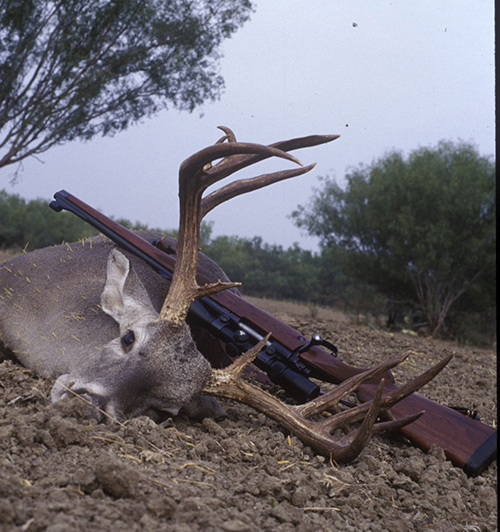
THE RANCH UPON WHICH THIS BUCK WAS SHOT called this deer a “Cull Buck”. Beauty is in the eyes of the beholder – even when holding a rifle or a bow. One study reported heritability of antler traits was meager. Tine length was only 49% heritable; other antler characteristics were below 28%. (Photo by John Jefferson)
by John Jefferson
We were on a 3,000-acre deer lease in Lampasas County for eleven years. It had a lot of open country, cattle and goats grazing throughout, too many does, and few bucks with a thirteen-inch inside spread (county antler restrictions).
Lampasas is a one-buck county. After one hunter shot his one buck, he asked what the lease rule was for “cull bucks.” He obviously wanted to shoot another buck. I explained that in a one buck county, he couldn’t legally shoot another buck. I added that several of the other hunters had not killed a buck, and if he were able to legally shoot another, it might deprive others of a buck.
What one man considers a “cull buck” might be a trophy for another hunter. He didn’t like my response.
An article by Lindsay Thomas Jr., Communications Officers for the National Deer Association, casts doubt on the alleged benefit of removing cull bucks. Texans have been removing “cull bucks” for years, believing that by taking them out of the breeding pool, only the best breeders would sire the buck fawns. That would lead to deer with much larger antlers.
Culling is simply removing bad apples from good ones. But I hesitate to call a “cull buck” a bad deer. To me, they’re all “good” unless they become aggressive to humans during their mating season (It happens!) or dash in front of my truck doing 70.
Thomas reviewed three studies that support what he called “Strike 3 for the Myth of the Genetic ‘Cull Buck’.” (Having played the game at several levels, I well understood his metaphor.)
The King Ranch study concluded that after eight years of studying two 9.4-thousand- acre pastures – one where lower Boone and Crocket scoring bucks were culled and the other where NO culling was done – that the antlers in the non-culled pasture were as large as the ones in the culled pasture! That study was done by Mickey Hellickson for his Ph.D. at the Caesar Kleberg Wildlife Research Institute (CKWRI) at Texas A&M-Kingsville.
The next study was done on the Comanche Ranch by Donnie Draeger, highly regarded wildlife manager of the ranch, with assistance from CKWRI and Mississippi State University. It studied 3,332 bucks on three large pastures over a seven-year period. Two were culled; the third one wasn’t.
The study showed increases in antler size in all pastures but benefitted from abundant rainfall. The conclusion was that culling was ineffective and that habitat improvement was the main influence.
On the Faith Ranch, a study involved two other large pastures — one culled and one unculled. The culled pasture showed a seven-inch increase in antlers over a fifteen-year period. But the conclusion was that improved nutrition alone caused more antler growth than intensive breeding.
Improving pastures and nutrition were more important than the “Titanic culling efforts.” The costs of such culling in manpower and time are high. Utilizing food plots, old field management, prescribed fire, brush control, and other tools look more effective – and certainly more affordable!
JJ




